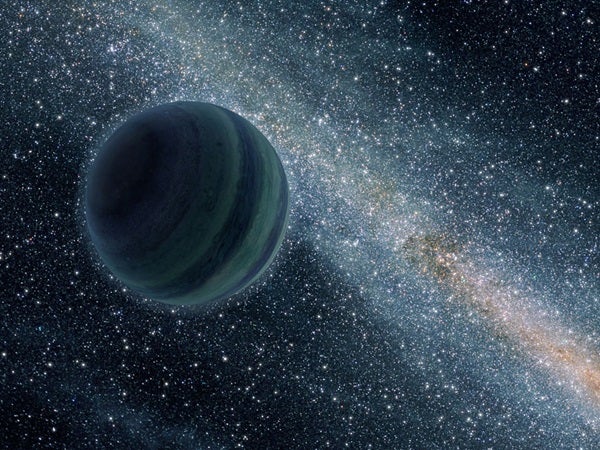The current number of detected Jupiter-sized planets either gravitationally bound to a central star or free-floating is large, and the count is increasing. The gravitational effects of these worlds on other planets could be substantial, but for the most part such dynamic interactions are confined to their nearby environs.
Ordinary, or baryonic, matter — like the material from which these planets form — interacts with photons to produce scattering, emission, or absorption against luminous sources. Dark matter, which is composed of nonbaryonic subatomic particles, does not interact with light in the same fashion.
A large number of detected and undetected Jupiter-sized planets could not mimic the gravitational effects produced by dark matter for two reasons. First, planets, although faint, are made of luminous matter and therefore are ultimately detectable. Second, their estimated numbers and locations, primarily around the galactic plane, do not support the large-scale gravitational effects similar to those of dark matter (like the ones explaining galactic rotation or the large-scale bending of light, called gravitational lensing).
Given the proper geometric alignment, however, Jupiter-sized planets could produce localized and temporary signal increases from background sources, a phenomenon known as the microlensing effect. This is precisely the mechanism by which we first detected free-floating planets. — Mario Perez, NASA Headquarters, Washington, D.C.
Ordinary, or baryonic, matter — like the material from which these planets form — interacts with photons to produce scattering, emission, or absorption against luminous sources. Dark matter, which is composed of nonbaryonic subatomic particles, does not interact with light in the same fashion.
A large number of detected and undetected Jupiter-sized planets could not mimic the gravitational effects produced by dark matter for two reasons. First, planets, although faint, are made of luminous matter and therefore are ultimately detectable. Second, their estimated numbers and locations, primarily around the galactic plane, do not support the large-scale gravitational effects similar to those of dark matter (like the ones explaining galactic rotation or the large-scale bending of light, called gravitational lensing).
Given the proper geometric alignment, however, Jupiter-sized planets could produce localized and temporary signal increases from background sources, a phenomenon known as the microlensing effect. This is precisely the mechanism by which we first detected free-floating planets. — Mario Perez, NASA Headquarters, Washington, D.C.










